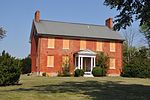Inwood, West Virginia
Census-designated places in Berkeley County, West VirginiaCensus-designated places in West VirginiaUse mdy dates from July 2023

Inwood is a census-designated place (CDP) in Berkeley County, West Virginia, United States, located south of Martinsburg in the lower Shenandoah Valley. The population was 2,954 at the 2010 census. It is located on U.S. Route 11.
Excerpt from the Wikipedia article Inwood, West Virginia (License: CC BY-SA 3.0, Authors, Images).Inwood, West Virginia
Gilmer Court,
Geographical coordinates (GPS) Address Nearby Places Show on map
Geographical coordinates (GPS)
| Latitude | Longitude |
|---|---|
| N 39.353333333333 ° | E -78.048888888889 ° |
Address
Gilmer Court 99
25428
West Virginia, United States
Open on Google Maps









